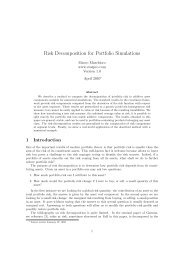analisi della performance di un portafoglio ... - Marco Marchioro
analisi della performance di un portafoglio ... - Marco Marchioro
analisi della performance di un portafoglio ... - Marco Marchioro
You also want an ePaper? Increase the reach of your titles
YUMPU automatically turns print PDFs into web optimized ePapers that Google loves.
particolare nel paragrafo 4.3.1) e zero rates che saranno calcolati attraverso<br />
l’utilizzo <strong>di</strong> particolari tecniche.<br />
Ricor<strong>di</strong>amo che la nostra strategia presuppone l’inclusione <strong>di</strong> calendar spreads su<br />
ogn<strong>un</strong>a delle tre commo<strong>di</strong>ties.<br />
Il prezzo <strong>di</strong> <strong>un</strong> calendar spread (riferito a <strong>un</strong>’<strong>un</strong>ità <strong>di</strong> commo<strong>di</strong>ty), costituito da<br />
<strong>un</strong>a posizione l<strong>un</strong>ga nella data e da <strong>un</strong>a posizione corta per lo stesso<br />
ammontare nella data , date intese come frazioni <strong>di</strong> anno, è dato dalla f<strong>un</strong>zione:<br />
(5.17)<br />
dove è il prezzo spot <strong>della</strong> commo<strong>di</strong>ty, e rappresentano i<br />
convenience yields <strong>della</strong> commo<strong>di</strong>ty rispettivamente alle date e , e<br />
sono gli zero rates associati a tali maturities.<br />
Non è quin<strong>di</strong> possibile prescindere dalla conoscenza dei fattori, <strong>di</strong>sco<strong>un</strong>t factors,<br />
zero rates e convenience yields, che vengono utilizzati nella f<strong>un</strong>zione <strong>di</strong> pricing<br />
del calendar spread.<br />
5.4.1 – DISCOUNT FACTORS<br />
Il <strong>di</strong>sco<strong>un</strong>t factor rappresenta <strong>un</strong>o dei concetti principali nell’ambito <strong>della</strong> finanza<br />
quantitativa, questo è il valore attuale <strong>di</strong> <strong>un</strong>’<strong>un</strong>ità <strong>di</strong> moneta <strong>di</strong>sponibile nel futuro.<br />
Nella (5.17), in<strong>di</strong>ca il valore attuale.<br />
(5.18)<br />
Il <strong>di</strong>sco<strong>un</strong>t factor rappresenta quin<strong>di</strong> il fattore per il quale <strong>un</strong> cash flow futuro<br />
deve essere moltiplicato al fine <strong>di</strong> ottenere il valore attuale.<br />
Si può notare che: quando i tassi <strong>di</strong> interesse sono positivi e quando la data<br />
precede si ha che:<br />
(5.19)<br />
Dato che i tassi <strong>di</strong> interesse sono espressi come percentuale <strong>di</strong> <strong>un</strong> certo ammontare<br />
l’anno e dovendo fronteggiare scadenze non necessariamente costituite da <strong>un</strong><br />
numero intero <strong>di</strong> anni, risulta conveniente esprimere le date come frazioni <strong>di</strong> anno<br />
(year fractions).<br />
82





